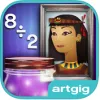Take a look inside 5 images
Mystery Math Museum
Pros: Content is customizable (operations and number ranges), and there are often multiple correct answers.
Cons: There is no feedback or help for incorrect answers, and questions can be answered incorrectly infinitely.
Bottom Line: Mystery Math Museum poses challenging math exercises in fun, engaging way, but lacks feedback for incorrect answers that would help kids who need additional support.
You can use Mystery Math Museum as a fun game for your students to practice arithmetic. The app offers unlimited user profiles, which makes it ideal for use even on a shared device. The game is most useful when customized to cover specific operations and ranges of numbers, so you'll want to show students how to set options on their own profiles (or set options for students yourself). A down side is that the app doesn't save data that would let students and teachers track progress.
Mystery Math Museum provides students with practice with addition, subtraction, multiplication, and division with numbers up to 50. Kids explore the rooms of museums to collect numbers; they then use these numbers to complete math equations to move from room to room. For example, you might collect the numbers 3, 4, 6, and 7, and have to complete the equation ___ + ___ = 10. When you correctly complete an equation, you can move to the next room in the museum. One of the best parts is that the game is customizable –- you can select the operations and ranges of numbers that will be used in equations in the game.
Each museum has a different theme, and within each museum, each room has a different theme. The complexity of the math covered increases with each level, and the different themes keep the game interesting and different. Every room is full of surprises -- for example, there are many items in each room that make funny sound effects when tapped. There are eight different museums with different themes, so it’s not a game that kids will finish too quickly.
Kids can learn addition, subtraction, and multiplication as well as algebraic thinking as they solve reverse math problems. Kids see the answer and the operation along with a variety of numbers, and they choose which numbers get their answer. Often, the equations have more than one correct answer, which helps to reinforce the concepts of fluency and equivalency. It is good for students who mostly understand the math concepts already, but it will be less helpful for students who struggle. When students answer a question incorrectly, there is no feedback other than letting them know the answer was incorrect. Students have three “lifelines” to skip difficult problems, but after those run out there is no further support.












